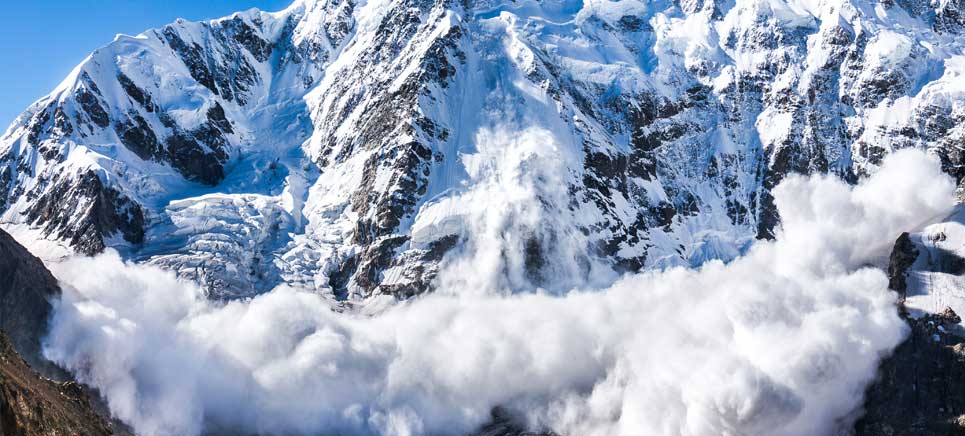It is likely that you may have come across one of those videos where a skier is followed by enormous amount of snow sliding down the mountain slope. Luckily, he/she skips the snow slide by a second or two and magically reappears once the snow movement is settled. This snow movement is called an avalanche. From the formation of an avalanche to its early prediction, there are much more interesting and deeper aspects of an avalanche which we are going to explore in this article.
What is an avalanche?
An avalanche is a swift movement of a large mass of snow, ice, or any other material down a sloped surface such as hills and mountains. At times, the word “snow slide” is also used in place of an avalanche. Most of the avalanches are unprompted and spontaneous. These natural disasters are known for creating some of the most dangerous yet spectacular sights.
What is an avalanche made of?
There are different types of avalanches and each avalanche may have different compositions depending on its type. However, a snow avalanche is primarily composed of snow and air.
What causes an avalanche?
An avalanche is triggered by four factors:
- Weak layer in a thick cover of snow, ice, or other material
- Inclined/slope terrain like a mountain or hill
- Weather conditions favoring an avalanche, particularly snowy and stormy winters.
- A triggering point
When the fragile snow plates at the uppermost part of the slope mountain collapse or gets fractured, it often results in an avalanche. This is one of the most common causes of an avalanche.
What triggers an avalanche?
Mountain slopes and hills are often prone to avalanches round the year. However, an avalanche does require a trigger to get started. That trigger can be both natural and human-induced. Heavy snowfall, snowstorms, earthquakes are all-natural triggers resulting in avalanches. Similarly, any human activity including walking and skiing can also trigger huge avalanches. It may take you by surprise that the majority of avalanche accidents are triggered by human-induced activities.

Avalanche Zones
There are three different zones of an avalanche. These zones are basically a sub-division of an avalanche path. These are the starting zone, the avalanche track, and the run-out zone.
The Starting Zone: It is the zone that triggers the avalanche.
The Avalanche Track: As the name suggests, it is a zone consisting of the natural track or path followed by an avalanche once it is triggered from the starting zone down the slope.
The Run-out Zone: The movement of the avalanche finally comes to a halt once it enters the run-out zone. This is the zone where snow and debris pile up at the bottom of the slope.
What are your chances of surviving an avalanche?
Chances of survival of an avalanche victim highly depend on the time frame within which she was rescued or found. The shorter the time span from the avalanche, the stronger the chances of survival. If a victim is found within the first 15 minutes, she has a 92% chance of survival. A serious decline in survival possibility is observed from 15 to 35 minutes and the chance of survival lower down to 30%.
There is almost no chance of survival after 2 hours.
If the victim is identified after two hours of an avalanche, there is hardly any chance of survival. The victim either succumbs to hypothermia or dies of injury.
Warning signs of an avalanche
Avalanches are spectacularly dangerous. Learning about some warning signs of a possible avalanche may help you protect yourself from possible avalanche danger. We are listing below some of the prominent signs of an avalanche:
- If you observe cracks in the snow beneath or around your feet or the ground feels hollow
- If you hear any thumping sound while walking on snow, it may be indicative of a possible avalanche
- Any shreds of evidence including the surface pattern indicating the strong force of wind or snowstorms.
- Heavy rain or snowfall for over a day
- A rapid increase in temperature within a very short span of time, particularly when the season transition is taking place. It is likely that this sudden dramatic increase in temperature may weaken the cohesive snow slabs and result in an avalanche.
Can we predict avalanches?
We have been using classical and conventional methods for forecasting an avalanche for a very long time. Gradually, with the advancement in technology, scientists have now started relying on analytical and statistical prediction methods. Even today, predicting an avalanche with certainty is difficult but we are getting a step closer to it with each technological upgradation. From infrared scanners to ultrasonic sensors and lasers, various expensive and precision-led tools are now being widely used by scientists to predict avalanches at different terrains.
Use the citation below to add this article to your bibliography
"Avalanche: Meaning, Causes, Prediction and Survival." Dashamlav.com. Web. 1 May 2025. <https://dashamlav.com/avalanche-meaning-causes-prediction-and-survival/>
Dashamlav.com, "Avalanche: Meaning, Causes, Prediction and Survival." Accessed 1 May 2025. https://dashamlav.com/avalanche-meaning-causes-prediction-and-survival/
"Avalanche: Meaning, Causes, Prediction and Survival." (n.d.). Dashamlav.com. Retrieved 1 May 2025 from https://dashamlav.com/avalanche-meaning-causes-prediction-and-survival/
